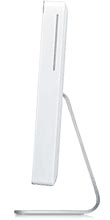 Apple have unveiled their new G5 iMac, with a radical break in the series’ all-in-one design. The iMac now comes in a 20” and 17” TFT format – and the whole computer is built into the screen, making it just 2” thick.
Apple have unveiled their new G5 iMac, with a radical break in the series’ all-in-one design. The iMac now comes in a 20” and 17” TFT format – and the whole computer is built into the screen, making it just 2” thick.
“Just like the iPod redefined portable digital music players, the new iMac G5 redefines what users expect from a consumer desktop,” said Philip Schiller, Apple’s senior vice president of Worldwide Product Marketing. “With the entire system, including a gorgeous 17- or 20-inch display, just two inches thin, a lot of people will be wondering ‘where did the computer go?'”
17” models come with 80 GB of disk, 1.8 Ghz processors and a SuperDrive or 1.6 Ghz chips and a combo CD-R/DVD drive. The 20” model has a 160 GB disk, a 1.8 Ghz processor and SuperDrive. The rest of the specifications are the same: 256MB of RAM, Firewire, GeForce FX5200 graphics cards and ethernet.
If you need more power, then you can specify up to 2 gig of memory and a 250 GB hard drive when ordering.
iMac
Published by

Fraser Lovatt
Fraser Lovatt has spent the last fifteen years working in publishing, TV and the Internet in various capacities, and believes that they will be seperate platforms for at least a while yet. His main interests at the moment are exploring where Linux is taking home entertainment and how technology is conferring technical skills on more and more people.
Fraser Lovatt was born in the same year that 2001: A Space Odyssey was delighting and confusing people in the cinemas, and developed a lifelong love of technology as soon as he realised that things could be taken apart, sometimes put back together again, but mostly left in bits or made into something the original designer hadn't quite planned upon.
At school he was definitely in the ZX Spectrum/Magpie/BMX camp, rather than the BBC Micro/Blue Peter/well-behaved group. This is all deeply ironic as he later went on to spend nine years working at the BBC.
After a few years of working as a bookseller in Scotland, ("Back when it was actually a skilled profession" he'll tell anyone still listening), he moved to England for reasons he can't quite explain adequately to himself. After a couple of publishing jobs punctuated by sporadic bursts of travelling and photography came the aforementioned nine years at the BBC where he specialised in internet technologies and video.
These days his primary interests are Java, Linux, videogames and pies - and if they're not candidates for convergence, then what is?
View all posts by Fraser Lovatt
 Apple have unveiled their new G5 iMac, with a radical break in the series’ all-in-one design. The iMac now comes in a 20” and 17” TFT format – and the whole computer is built into the screen, making it just 2” thick.
Apple have unveiled their new G5 iMac, with a radical break in the series’ all-in-one design. The iMac now comes in a 20” and 17” TFT format – and the whole computer is built into the screen, making it just 2” thick.